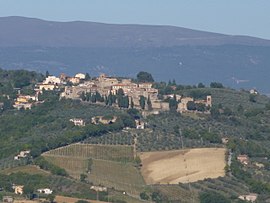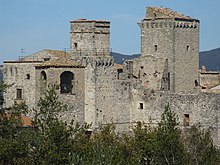Gualdo Cattaneo
| Gualdo Cattaneo | ||
|---|---|---|

|
|
|
| Country | Italy | |
| region | Umbria | |
| province | Perugia (PG) | |
| Coordinates | 42 ° 55 ' N , 12 ° 33' E | |
| height | 446 m slm | |
| surface | 96.79 km² | |
| Residents | 5,827 (Dec. 31, 2019) | |
| Population density | 60 inhabitants / km² | |
| Post Code | 06035 | |
| prefix | 0742 | |
| ISTAT number | 054022 | |
| Popular name | Gualdesi | |
| Website | Gualdo Cattaneo | |
 Panorama from Gualdo Cattaneo |
||
Gualdo Cattaneo is an Italian commune with 5827 inhabitants (as of December 31, 2019) in the province of Perugia in the Umbria region .
geography
The municipality is located about 26 km southeast of Perugia on the Attone and Puglia rivers and is in the climatic classification of Italian municipalities in Zone E, 2243 GR / G. The place belongs to the community Comunità montana dei Monti Martano e Serano . The municipality is part of the Associazione Nazionale Città del Vino and the Associazione Nazionale Città dell'Olio .
The districts (Frazioni) include:
- Barattano (454 m above sea level, approx. 17 km southeast, approx. 25 inhabitants)
- Grutti (506 m, approx. 9.5 km southwest, approx. 530 inhabitants)
- Marcellano (396 m, located approx. 10 km southeast, approx. 430 inhabitants)
- Pomonte (461 m, located approx. 5 km southeast, approx. 60 inhabitants)
- San Terenziano (505 m, approx. 8.5 km southwest, approx. 100 inhabitants)
- Torri (450 m, located approx. 7 km southwest, approx. 1000 inhabitants)
- as well as Ceralto , Cerquiglino , Cisterna , Collesecco , Ponte di Ferro , Pozzo and Saragano .
The neighboring municipalities are Bettona , Bevagna , Cannara , Collazzone , Giano dell'Umbria , Massa Martana , Montefalco and Todi .
history
According to legend, the place was founded as a castle (Castello) by the Germanic Count Edoardo Cattaneo in 975 as Gualdum Captaneorum . The first part of the name comes from the Germanic word for forest (Bald). In 1071 the place fought on the side of Spoleto against Foligno , who could not take the place until 1177 under Barbarossa . As early as 1198 the place belonged again to Spoleto and with them submitted to the Papal States . After that, the Trinci took over rule in the place until 1439, which was then re-incorporated into the Papal States. In 1493 Pope Alexander VI. the place as a fief to Foligno. After the French occupation of Italy by Napoleon , the place was again part of the Papal States until 1861. After the unification of Italy in 1861, the population rose from approx. 3,170 to 8,000 in 1951. After a brief low in the 1970s, the population rose to approx. 6000 inhabitants.
Attractions
Churches
- Chiesa di Sant'Andrea , church from the 14th century in the district of Marcellano, contains works by Andrea Polinori
- Chiesa di Sant'Agostino , built by the Benedictines in the 12th century, was taken over by the Augustinians in the 13th century . Contains works by the painter Andrea Polinori and a Crocifissione from the environment of Niccolò Alunno .
- Chiesa di Sant'Angelo Sconsolo , ex-church in the district of Marcellano, which was built in the 12th century
- Chiesa dei Santissimi Antonio e Antonino , church from 1260
- Chiesa di San Bartolomeo , church in the Barattano district from the 13th century
- Chiesa di Santa Maria d'Agello , church in Grutti from the 13th century
- Chiesa dei Santissimi Terenziano e Flacco , church in the district of San Terenziano from the 11th century
Castles
- Castello di Barattano , castle from the 13th century
- Castello di Grutti , castle from the 12th century
- Castello di San Terenziano , castle from the 14th century
- Castello di Speltara , castle from the 13th century near the district of San Terenziano
- Forte di Gregorio XII , 1415 by Gregory XII. resulting fortress in the district of Pomonte
- Rocca di Gualdo Cattaneo , a fortress built between 1494 and 1498, which the rulers from Foligno built over an older construction of the Trinci family.
literature
- TCI : Umbria. Milan 1999, ISBN 88-365-2542-3 , p. 512
Web links
- Official website of the municipality of Gualdo Cattaneo (Italian)
- Data and information on Gualdo Cattaneo at Comuni Italiani (Italian)
- Pro Loco Gualdo Cattaneo Website of the Pro Loco in Gualdo Cattaneo (Italian)
Individual evidence
- ↑ Statistiche demografiche ISTAT. Monthly population statistics of the Istituto Nazionale di Statistica , as of December 31 of 2019.
- ↑ Official website of the Associazione Nazionale Città del Vino , accessed on December 16, 2017 (Italian)
- ↑ Comuni italiani on the communities of the Associazione Nazionale Città dell'Olio , accessed on December 16, 2017 (Italian)
- ↑ Official website of the municipality of Gualdo Cattaneo on the history of the place , accessed on December 16, 2017 (Italian)




